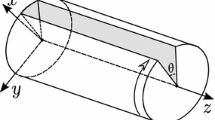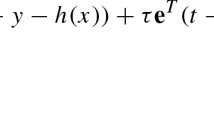Abstract
It is well known that complementarity functions play an important role in dealing with complementarity problems. In this paper, we propose a few new classes of complementarity functions for nonlinear complementarity problems and second-order cone complementarity problems. The constructions of such new complementarity functions are based on discrete generalization which is a novel idea in contrast to the continuous generalization of Fischer–Burmeister function. Surprisingly, these new families of complementarity functions possess continuous differentiability even though they are discrete-oriented extensions. This feature enables that some methods like derivative-free algorithm can be employed directly for solving nonlinear complementarity problems and second-order cone complementarity problems. This is a new discovery to the literature and we believe that such new complementarity functions can also be used in many other contexts.





Similar content being viewed by others
References
Baggett L (2012) Analysis of Functions of a Single Variable, University of Colorado, http://cnx.org/content/col11249/1.1/. Accessed 10 Sept 2017
Bertsekas DP (1999) Nonlinear programming, 2nd edn. Athena Scientific, Belmont
Chang Y-L, Chen J-S, Yang C-Y (2015) Symmetrization of generalized natural residual function for NCP. Oper Res Lett 43:354–358
Chen J-S, Tseng P (2005) An unconstrained smooth minimization reformulation of the second-order cone complementarity problem. Mathe Program 104:293–327
Chen J-S (2006) The semismooth-related properties of a merit function and a descent method for the nonlinear complementarity problem. J Glob Optim 36:565–580
Chen J-S (2006) Two classes of merit functions for the second-order cone complementarity problem. Mathe Methods Oper Res 64:495–519
Chen J-S (2007) On some NCP-functions based on the generalized Fischer-Burmeister function. Asia Pac J Oper Res 24:401–420
Chen J-S, Gao H-T, Pan S (2009) A \(R\)-linearly convergent derivative-free algorithm for the NCPs based on the generalized Fischer-Burmeister merit function. J Comput Appl Math 232:455–471
Chen J-S, Huang Z-H, She C-Y (2011) A new class of penalized NCP-functions and its properties. Comput Optim Appl 50:49–73
Chen J-S, Ko C-H, Pan S-H (2010) A neural network based on generalized Fischer-Burmeister function for nonlinear complementarity problems. Inf Sci 180:697–711
Chen J-S, Pan S-H (2008) A family of NCP-functions and a descent method for the nonlinear complementarity problem. Comput Optim Appl 40:389–404
Chen J-S, Pan S-H (2012) A survey on SOC complementarity functions and solution methods for SOCPs and SOCCPs. Pac J Optim 8:33–74
Chen J-S, Chen X, Tseng P (2004) Analysis of nonsmooth vector-valued functions associated with second-order cones. Math Program 101:95–117
Chen J-S, Pan S-H, Lin T-C (2010) A smoothing Newton method based on the generalized Fischer-Burmeister function for MCPs. Nonlinear Anal 72:3739–3758
Chen J-S, Pan S-H, Yang C-Y (2010) Numerical comparison of two effective methods for mixed complementarity problems. J Comput Appl Math 234:667–683
Chen J-S, Ko C-H, Wu X-R (2016) What is the generalization of natural residual function for NCP. Pac J Optim 12:19–27
Cottle RW, Pang J-S, Stone RE (1992) The linear complementarity problem. Academic Press, New York
Dolan ED, Morè JJ (2002) Benchmarking optimization software with performance profiles. Math Program 91:201–213
Faraut J, Korányi A (1994) Analysis on symmetric cones. Oxford University Press, Oxford Mathematical Monographs, New York
Fletcher R (1987) Practical methods of optimization, 2nd edn. Wiley-Interscience, Chichester
Facchinei F, Pang J-S (2003) Finite-dimensional variational inequalities and complementarity problems. Springer Verlag, New York
Facchinei F, Soares J (1997) A new merit function for nonlinear complementarity problems and a related algorithm. SIAM J Optim 7:225–247
Fischer A (1992) A special Newton-type optimization methods. Optimization 24:269–284
Fischer A (1997) Solution of the monotone complementarity problem with locally Lipschitzian functions. Math Program 76:513–532
Fukushima M, Luo Z-Q, Tseng P (2002) Tseng smoothing functions for second-order cone complementarity problems. SIAM J Optim 12:436–460
Galántai A (2012) Properties and construction of NCP functions. Comput Optim Appl 52:805–824
Geiger C, Kanzow C (1996) On the resolution of monotone complementarity problems. Comput Optim Appl 5:155–173
Hayashi S, Yamashita N, Fukushima M (2005) Robust Nash equilibria and second-order cone complementarity problems. J Nonlinear Convex Anal 6:283–296
Harker PT, Pang J-S (1990) Finite dimensional variational inequality and nonlinear complementarity problem: a survey of theory, algorithms and applications. Math Program 48:161–220
Hu S-L, Huang Z-H, Chen J-S (2009) Properties of a family of generalized NCP-functions and a derevative free algotithm for complementarity problems. J Comput Appl Math 230:69–82
Jiang H (1996) Unconstrained minimization approaches to nonlinear complementarity problems. J Glob Optim 9:169–181
Kanzow C (1996) Nonlinear complementarity as unconstrained optimization. J Optim Theory Appl 88:139–155
Kanzow C, Kleinmichel H (1995) A class of Netwton-type methods for equality and ineqality constrained optimization. Optim Methods Softw 5:173–198
Koshy T (2007) Elementary number theory with applications, 2nd edn. Academic Press, Cambridge, London
Kanno Y, Martins AC, da Costa A pinto (2006) Three-dimensional quasi-static frictional contact by using second-order cone linear complementarity problem. Int J Numer Methods Eng 65:62–83
Mangasarian OL (1976) Equivalence of the complementarity problem to a system of nonlinear equations. SIAM J Appl Math 31:89–92
Pan S-H, Chen J-S (2010) A linearly convergent derivative-free descent method for the second-order cone complementarity problem. Optimization 59:1173–1197
Pan S-H, Kum S, Lim Y, Chen J-S (2014) On the generalized Fischer-Burmeister merit function for the second-order cone complementarity problem. Math Comput 83:1143–1171
Pang J-S (1990) Newton’s method for \(B\)-differentiable equations. Math Oper Res 15:311–341
Pang J-S, Chan D (1982) Iterative methods for variational and complemantarity problems. Math Program 27:284–313
Sun D, Qi L (1999) On NCP-functions. Comput Optim Appl 13:201–220
Tsai H-Y, Chen J-S (2014) Geometric views of the generalized Fischer-Burmeister function and its induced merit function. Appl Math Comput 237:31–59
Yamashita N, Fukushima M (1995) On stationary points of the implict Lagrangian for nonlinear complementarity problems. J Optim Theory Appl 84:653–663
Yamashita N, Fukushima M (1997) Modified Newton methods for solving a semismooth reformulation of monotone complementarity problems. Math Program 76:469–491
Author information
Authors and Affiliations
Corresponding author
Additional information
Communicated by Jinyun Yuan.
Peng-Fei Ma This research was supported by a grant from the National Natural Science Foundation of China(No.11626212).
Jein-Shan Chen The author’s work is supported by Ministry of Science and Technology, Taiwan.
Rights and permissions
About this article
Cite this article
Ma, PF., Chen, JS., Huang, CH. et al. Discovery of new complementarity functions for NCP and SOCCP. Comp. Appl. Math. 37, 5727–5749 (2018). https://doi.org/10.1007/s40314-018-0660-0
Received:
Revised:
Accepted:
Published:
Issue Date:
DOI: https://doi.org/10.1007/s40314-018-0660-0




